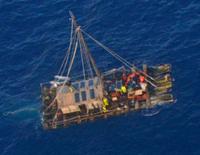 Last November, we posted about two balsa rafts which had set out from Lima, Peru, intending to sail to Easter Island and back, on the Kon-Tiki 2 expedition. Yesterday, the Chilean Navy rescued 14 crew members from the two rafts after they had been swept far off course by currents as the rafts were on the return leg of the voyage.
Last November, we posted about two balsa rafts which had set out from Lima, Peru, intending to sail to Easter Island and back, on the Kon-Tiki 2 expedition. Yesterday, the Chilean Navy rescued 14 crew members from the two rafts after they had been swept far off course by currents as the rafts were on the return leg of the voyage.
The voyage was intended both as an homage to Thor Heyerdahl’s famous voyage on the raft Kon-Tiki in 1947 and a voyage to collect data on climate change, ocean currents, marine life and plastic pollution. This expedition attempted to steer the rafts using adjustable “guara boards,” but were still unable to keep to their intended course.
While Heyerdahl theorized that Polynesia had been populated by sailors drifting or sailing downwind on rafts, Polynesian tradition holds that ancestral sailors made long ocean voyages is sailing canoes. In the 1970s, in part in response to Heyerdahl’s theories, a group of sailors, engineers and artists, got together in Hawaii to build a traditional voyaging canoe. In 1976, they sailed the canoe, named Hōkūleʻa, from Hawaii to Tahiti and back, relying on only traditional navigation techniques, demonstrating that Polynesian sailors could both navigate and sail under a wide range of ocean conditions.
Hōkūleʻa is now in the third year of a worldwide voyage and is currently making a port call in Cuba. Over the last 40 years, Hōkūleʻa has sailed over 150,000 across the Pacific. In its current voyage, which began in 2013, Hōkūleʻa called on 24 islands and six countries throughout Polynesia before sailing on to New Zealand, Australia, South Africa and now Brazil. This summer, Hōkūleʻa will visit the US East Coast, before turning east to the Azores, Portugal and Italy. Hōkūleʻa is expected to return to the Pacific in 2017.
Thanks to AB from NY for passing along the news of the Kon-Tiki 2 rescue.
